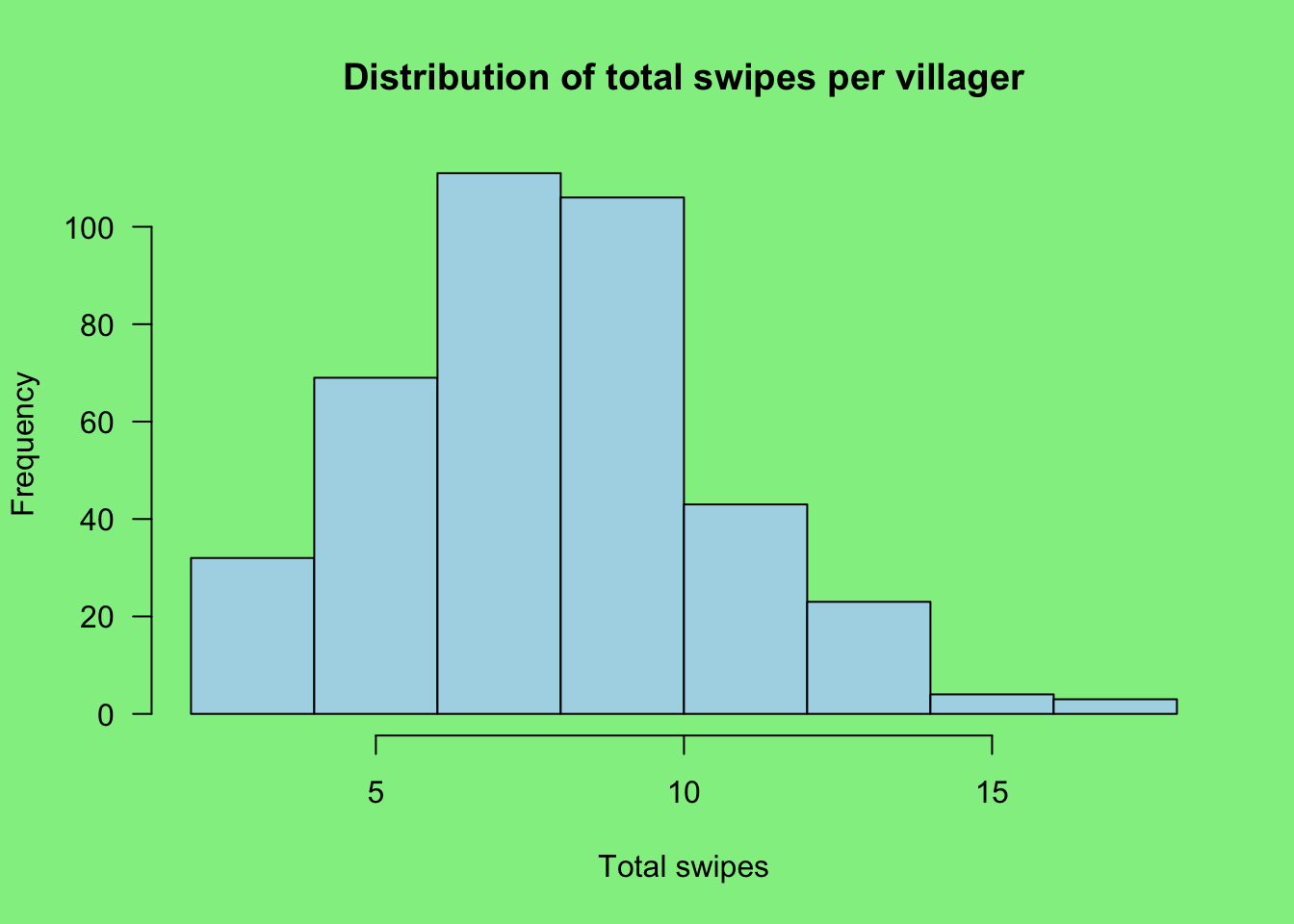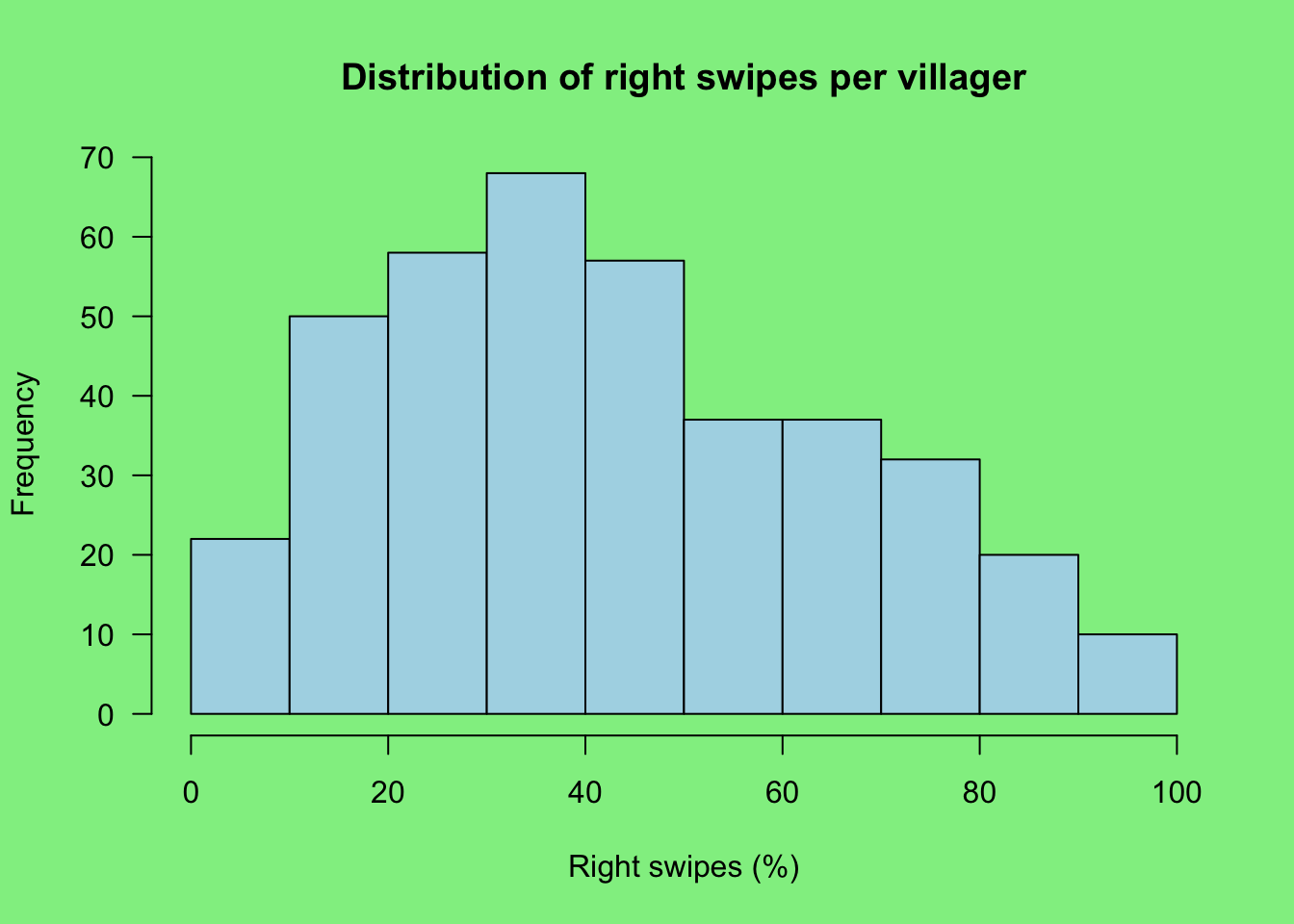
tl;dr
I once wrote an R Shiny app to run a popularity contest for Animal Crossing villagers. Surprise: cute ones are favourites.
Swiping {shinyswipe} code
A while back I wrote a Shiny app (site, source, blogpost) for TidyTuesday to replicate a Tinder-like experience using villagers from Nintendo’s Animal Crossing New Horizons game. It uses the swipe mechanic from Nick Strayer’s {shinysense} package to gauge popularity: left for a ‘dislike’, right for a ‘like’.
After exceeding 3000 total swipes, it’s time to take a look at the results.
Oh sheet
Data from each swipe in the app is automatically appended to a public Google Sheets sheet that can be read with {googlesheets4}. Public sheets don’t require authentication to download, so run gs4_deauth() before read_sheet() to prevent it.
library(googlesheets4)
gs4_deauth()
raw <- read_sheet(
ss = "1kMbmav6XvYqnTO202deyZQh37JeWtTK4ThIXdxGmEbs",
col_types = "Tcc" # datetime, char, char
)## ✓ Reading from "acnh-swipe_results".## ✓ Range 'Sheet1'.First thing is to isolate the left and right swipes only. The {shinysense} package also allows for up and down swipes by default and I wasn’t sure how to remove this capability from my app (i.e. work lazier, not harder).
dat <- raw[raw$swipe %in% c("left", "right"), ]
dat[sample(rownames(dat), 5), ] # random sample## # A tibble: 5 × 3
## date name swipe
## <dttm> <chr> <chr>
## 1 2021-01-31 22:48:29 Renée right
## 2 2020-11-09 02:16:26 Kid Cat right
## 3 2022-01-08 05:27:15 Agent S right
## 4 2020-09-29 04:18:40 Cleo right
## 5 2020-09-15 07:25:45 Goose leftThe data are one row per swipe, with columns for date (datetime of when the swipe happened), name (the villager’s name) and swipe (the swipe direction).
But what we’re really after is a grouped table with a row per villager, plus new columns for the total number of swipes, the difference between right and left swipes and the percentage of swipes that were to the right (pc_right). These will let us better rank the characters.
df <- with(dat, table(name, swipe)) |> # like dplyr::count()
as.data.frame(responseName = "n") |>
reshape( # like tidyr::pivot_*()
v.names = "n", # values_from
idvar = "name", # id_cols
timevar = "swipe", # names_from
direction = "wide", # i.e. pivot_wider()
sep = "_" # names_sep
) |>
transform( # like dplyr::mutate()
total = n_left + n_right,
diff = n_right - n_left,
pc_right = 100 * round(n_right / (n_right + n_left), 2)
)
head(df)## name n_left n_right total diff pc_right
## 1 Admiral 5 4 9 -1 44
## 2 Agent S 6 3 9 -3 33
## 3 Agnes 4 5 9 1 56
## 4 Al 6 3 9 -3 33
## 5 Alfonso 5 5 10 0 50
## 6 Alice 3 7 10 4 70I think most readers of this blog are probably {tidyverse} users, so I’ll explain some of the base R approach I took here:
- I’ve used the base pipe (
|>) introduced in R v4.1 to chain the functions, which is analogous to {magrittr}’s pipe (%>%) in this example with()allows the bare column names intable()to be evaluated as columns ofdat, which means you only write the name of the data object once- a
table()coerced withas.data.frame()is equivalent todplyr::count(), basically reshape()can be used liketidyr::pivot_wider()(I’ve added comments in the code block above to show how the arguments are used)- turns out that
transform()can be used likedplyr::mutate()to create new columns, thought the help files say it should only be used for interactive and that ‘you deserve whatever you get!’
We can also bring in some additional villager data collected for TidyTuesday and join it to the swipe data. This will come in useful later.
tt <- read.csv(
paste0(
"https://raw.githubusercontent.com/rfordatascience/tidytuesday/",
"2e9bd5a67e09b14d01f616b00f7f7e0931515d24/data/",
"2020/2020-05-05/villagers.csv"
)
)
df <- merge(df, tt, by = "name")New Horizons scanning
There are 391 villagers represented in these data, with a combined total of 3234 legitimate swipes.
The total swipes per villager ranged from 2 to 17, with a mean of 8.3±2.7, so some characters didn’t really get enough swipes for proper assessment. You’d better go to the app and add some more swipes, eh?
par(bg = "lightgreen")
hist(
df$total,
main = "Distribution of total swipes per villager",
xlab = "Total swipes",
col = "lightblue",
las = 1
)
What if we look now at right swipes (i.e. ‘likes’), adjusted for the total swipes per character?
par(bg = "lightgreen")
hist(
df$pc_right,
main = "Distribution of right swipes per villager",
xlab = "Right swipes (%)",
col = "lightblue",
las = 1
)
You can see that the distribution isn’t quite normal. The frequency of swipes below 50% is 227 and above 50% is 136. This implies that the majority of characters were disliked in a binary sense.
The bins at 0 and 100% tell you that there were some characters that were met with universal disapproval and approval, while the bin at 50% tells us that same characters split people’s opinions. Which were they?
Drumroll, please
So, onto the villager rankings.
I’ve written a little function to output an HTML table where each character’s name links to their profile on the Animal Crossing Wiki and exposes their photo from VillagerDB.
entable <- function(df) {
df$url <- paste0(
"<img src='", df$url, "' ",
"width=50 ",
"alt='Animal Crossing villager ", df$name,"'>"
)
df$name <- paste0(
"<a href='https://animalcrossing.fandom.com/wiki/",
df$name, "'>", df$name, "</a>"
)
df <- df[, c("name", "url", "pc_right", "total")]
names(df) <- c("Name", "Picture", "Right swipes (%)", "Total swipes")
rownames(df) <- NULL
knitr::kable(df)
}Least popular
To build tension, we’ll start with the least-liked villagers.
bot <- df[order(df$pc_right, -df$n_left), ] |> head()
entable(bot)| Name | Picture | Right swipes (%) | Total swipes |
|---|---|---|---|
| Pinky |  |
0 | 12 |
| Cashmere |  |
0 | 9 |
| Greta |  |
0 | 9 |
| Harry |  |
0 | 9 |
| Curly |  |
0 | 8 |
| Benedict |  |
0 | 7 |
Sorry Pinky. You are simply… too pink? Seems harsh.
Most polarising
To build even more tension, let’s look at the characters who had a 50:50 ratio of likes to dislikes.
meh <- subset(df[order(-df$total), ], diff == 0) |> head()
entable(meh)| Name | Picture | Right swipes (%) | Total swipes |
|---|---|---|---|
| Chevre |  |
50 | 14 |
| Julian |  |
50 | 12 |
| Static |  |
50 | 12 |
| Vivian |  |
50 | 12 |
| Alfonso |  |
50 | 10 |
| Blaire |  |
50 | 10 |
I’m not sure why these villagers are so controversial Perhaps they’re too ‘plain’ for some people? But Julian is a unicorn! With a sick space-themed hoody!
Most popular
And finally, what you’ve all been waiting for.
top <- df[order(-df$pc_right, -df$n_right), ] |> head()
entable(top)| Name | Picture | Right swipes (%) | Total swipes |
|---|---|---|---|
| Bea |  |
100 | 9 |
| Bill |  |
100 | 9 |
| June |  |
100 | 8 |
| Ellie |  |
100 | 7 |
| Aurora |  |
100 | 4 |
| Eugene |  |
100 | 4 |
So! Bea and Bill were unanimously approved with nine right swipes each. I think the key trait here is ‘cuteness’: the favourites are generally small, big-eyed villagers (and Eugene’s Terminator aesthetic is charming on a koala).
Although Bill is staring directly into my soul.
Speciesism!
I know what you’re thinking: the results are on a villager-by-villager basis, but which species are the most popular? We can aggregate swipes and take a look.
sp_l <- aggregate(n_left ~ species, sum, data = df)
sp_r <- aggregate(n_right ~ species, sum, data = df)
sp_n <- with(df, table(species)) |>
as.data.frame(responseName = "n_villagers")
sp <- sp_n |>
merge(sp_l, by = "species") |>
merge(sp_r, by = "species") |>
transform(
total = n_right + n_left,
pc_right = 100 * round(n_right / (n_right + n_left), 2)
)A couple more base functions here for those not used to them:
aggregate()is likedplyr::group_by()followed bydplyr::summarise()and it allows for compact ‘formula syntax’, so we can say ‘aggregate y by x’ withy ~ xmerge()is just like thedplyr::*_join()family
So, firstly, the species ranked by lowest proportion of right swipes.
sp_bot <- sp[order(sp$pc_right, -sp$n_left), ]
rownames(sp_bot) <- NULL
head(sp_bot)## species n_villagers n_left n_right total pc_right
## 1 mouse 15 90 19 109 17
## 2 eagle 9 54 17 71 24
## 3 hippo 7 43 15 58 26
## 4 bull 6 40 14 54 26
## 5 bear 15 87 32 119 27
## 6 chicken 9 49 20 69 29I can see how eagles, monkeys and hippos might not be that ‘cute’, per se, but what about the mice? Although ‘cute’ is probably not the best term for the cranky mouse Limberg (sorry Limberg).
What about the most liked species?
sp_top <- sp[order(-sp$pc_right, sp$n_right), ]
rownames(sp_top) <- NULL
head(sp_top)## species n_villagers n_left n_right total pc_right
## 1 octopus 3 6 18 24 75
## 2 koala 9 17 43 60 72
## 3 cub 16 43 74 117 63
## 4 dog 16 49 80 129 62
## 5 deer 10 43 67 110 61
## 6 wolf 11 33 50 83 60Octopuses are on top, although there’s relatively few octopus villagers. Personally, I like Zucker, an octopus who looks like takoyaki and therefore delicious.
This wasn’t meant to be about villager tastiness, was it? We may need a new app to rank by apparent edibility…